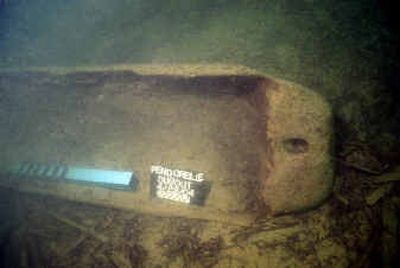Old dugout found in lake isn’t so old

Scuba divers might have discovered the old dugout canoe, but the sunken boat and its story might never be pulled from the depths of Lake Pend Oreille.
Wood samples from the canoe are too young to yield a precise age through carbon dating, meaning the boat is less than 380 years old but probably at least 100 years old, said Mary Anne Davis, associate state archaeologist with the Idaho State Historical Society.
“Radiocarbon dating is not very accurate for fairly recent deposits or objects,” she said.
The fate of the canoe is uncertain. For now, it will remain resting on its side in a secret location 40 feet below the surface. Among the groups interested in the canoe are the American Indian tribes that traditionally traveled the lake.
Although the canoeists didn’t paddle ice-age meltwater and the dugout is younger than the ships that carried Vikings, Christopher Columbus and the Pilgrims, the dugout still has considerable cultural and historical value.
“It’s very significant,” Davis said. “It just offers up a lot of potential information. If it’s from during the time of the fur traders, that’s just amazing. They didn’t leave much behind.”
Two divers from Sandpoint stumbled across the canoe in 40 feet of water on New Year’s Day. Mark Jones spotted the dugout while pausing during the dive because of problems equalizing the pressure in his ears. His dive buddy, Sid Redfield, then snapped underwater photos before silt fanned by the divers’ foot fins obscured the carved log.
The divers shared their information with a network of local historians. Before long, the discovery caught the attention of an expert team from the National Park Service’s Submerged Resources Division. In late April, the underwater archaeologists worked with Jones and Redfield to document the find over the course of seven dives in 41-degree water.
Laboratory samples recently revealed that the dugout was carved from a ponderosa pine log, Davis said. Although the precise age is unknown, Davis suspects the canoe was built sometime after 1800, but before 1882. The end date was revealed not from the wizardry of technology, but because of the persistent sleuthing of Ann Ferguson, the curator of the Bonner County Museum.
Fractured rock resting in the bottom of the canoe led Ferguson to believe that it sank before blasting occurred on a nearby shore during railroad construction in 1882. Ferguson also searched ethnographic documents and found dugouts were not commonly used by the Kalispel and Kootenai tribes.
“This canoe could have been made by Native Americans, fur traders or early Euro-American settlers,” Ferguson said, in a written statement. “Its history may never be completely known to us, but it definitely plays an important part in the story of early transportation in northern Idaho.”
Francis Cullooyah, director of the Kalispel Tribe’s culture program, said white pine bark was traditionally the preferred construction material for canoes used on Lake Pend Oreille and nearby rivers. “That’s not saying that our people may have used dugouts. I would imagine at some point in time maybe there were dugout canoes, but I have never personally seen anything to that effect.”
The Kalispels fished the lake. They picked berries and hunted game in nearby hills. Their horses grazed thick grass along the shore.
Cullooyah said the tribe has been consulted frequently during the archaeological investigation. He’s just as mystified as the scientists as to the origin and owner of the canoe. Maybe it floated away from shore and was swamped by waves, he said. There’s a small chance the canoe could have been sunk as a burial vessel.
“Who knows? At this point it’d be hard to say,” Cullooyah said. “Of course, I wouldn’t want to go out on the lake in a small craft like that.”
The Kalispel Tribe doesn’t have a strong position on the fate of the canoe, he added.
“If it’s left in the water that would be fine,” Cullooyah said. “Just to have it protected. As long as we know that it’s there.”
Tim Ryan, culture and resources manager for the Confederated Salish and Kootenai Tribes, said raising the dugout should be studied. “We don’t see them very often. It would be a significant cultural resource that would be worth preserving.”
Like any other artifact or natural resource on the bottom of an Idaho lake, the canoe is technically the property of the state, said Jim Brady, with the Idaho Department of Lands. But the state is “more than willing” to allow a tribe to remove the canoe, so long as it is properly preserved and publicly displayed, he said.
When the boat was discovered, there was considerable local interest in preservation and display at the county museum, Brady said. The preservation process for submerged wood involves a time-consuming process of soaking the wood in chemical baths with varying degrees of strength.
The canoe’s relatively young age and the high cost of preservation have dampened the enthusiasm.
“The money that was going to pay for the preservation was actually coming from private individuals,” Brady said.
“Since it’s not as old as initially thought, the interest to get that kind of money is not as strong.”
The boat’s location will be kept secret, Brady said, just as it is with the paddlewheelers, cement barges and other passenger boats hidden in the waters of Pend Oreille and Coeur d’Alene lakes. Some mysteries are better left for another generation to solve, he said.